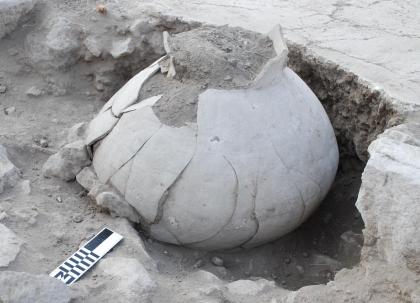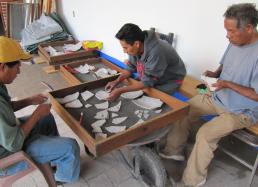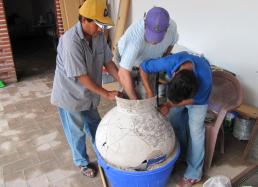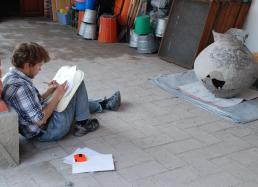10: Patience, Persistence, and A Really Big Jar
Our project now has made the transition from the field to the lab. With the semester over, our more experienced North American project members have arrived, and analysis, coding, illustration, digital photography, and map preparation all are in full swing. Linda and I have broken up long days in the lab by entertaining several visiting groups and by giving a lecture to students and faculty at Mitla’s technical high school.
During these brief talks, we speak of our research, prefaced with more general background concerning the rich and long history of the Mitla area and the Valley of Oaxaca. When speaking in these contexts, we also try to dispel an all-too-prevalent myth regarding archaeology, a myth that unfortunately was concretized by Indiana Jones. Professional archaeology is not treasure hunting. In fact, the recovery of pieces of art generally is not the prime goal of archaeological investigation.
Archaeology is a historical science, usually undertaken with comparative goals that endeavor to understand why and how the long course of history has differed from one region of the world to another. Here, in the Valley of Oaxaca (as I’ve remarked before), beyond dedicated, systematic archaeological research, there are few alternatives for learning much regarding the region and people’s history before the Spanish Conquest.
Contemporary archaeology is much more about patience, persistence, discipline, and laboratory work than it is about “eureka moments” and especially swashbuckling. No question, discoveries—whether of things or ideas—are wonderful (and they do help sustain us), but the slow piecing together of long-term history is how we spend most of our time.
In my sixth dispatch from this year, “Water,” we described two large jars that we’d found on the east side of the Terrace 276 residential complex. One of the jars remained mostly intact (see above photo), although clearly it was cracked into many pieces by centuries of root activity. After we found this jar, we waited for weeks to study it further until we were ready to examine the occupation surface below the one where it was first placed. For those weeks, every night, we surrounded the jar with sandbags and covered it with a screen to prevent someone from accidentally toppling it or walking on it.
What did the jar contain when it was in use? If it contained the alcoholic beverage pulque, one might expect the jar’s interior to be pocked. If it held water, as we suspected, then the interior would not be so scarred. When it came time to excavate the jar, we knew that we probably had enough of it to re-piece together, but how to proceed? In conjunction with several of our most experienced local workers, we decided to number the pieces of the jar as we excavated it, placing adjacent parts together in separate bags (see Photo #1 below.)
Digging out the jar confirmed that it likely was used to hold water and that, when it was situated more than a millennium ago, the Terrace 276 residents constructed a special rounded base (below the room floor) for this giant vessel. By keeping most of the vessel underground, the water that this jar held would have remained cool.
Once back in the lab, we had nine bags of pottery—roughly 50 pounds worth—all from the jar! At that point, Genaro (one of our local workmen who had helped excavate the jar)—with assistance from two of our experienced workers, Juan and Rolando—began a long, tedious effort to reconstruct this large vessel. Starting at the base, bit by bit the men pieced the olla (water jar) together, eventually using a plastic tub filled with sand to provide necessary support (see Photos #2-4.)
After almost a week and a great deal of patience, the jar was reassembled with only a few pieces missing. We were rewarded with a new perspective on the vessel, different from that which we’d had in the field, as much of the rim had fallen inside during subsequent remodelings of the Terrace 276 residence. Once the olla was stable, we removed it gingerly from its bed of sawdust and had it illustrated (see Photo #5.)
Although rebuilding the jar has not overturned any theories or revised any of our interpretations, it does symbolize the basic values, care, patience, persistence, attentiveness, and organization that so much of the archaeological process demands.
More soon,
Gary









